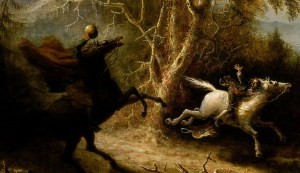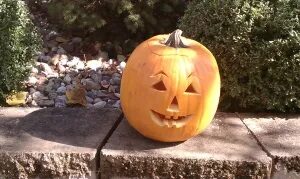Halloween has never been one of my favorite holidays. As a kid, I suppose I enjoyed the candy. But even then, it was trouble to find a costume, and the weather generally did not cooperate. The one good thing about my childhood Halloweens was that Catholic school kids got the following day off, because All Saint’s Day (November 1) is a Catholic holy day, and we had to go to Mass with our families. So Catholic kids could stay out later on Halloween.
Halloween was not a widely recognized holiday in the U.S. in the 1840s and 1850s, so I haven’t featured the holiday in my novels set in mid-19th century America. But I have researched the history of Halloween.
Halloween originated with the ancient Celts, who lit bonfires, made jack-o-lanterns, and wore costumes to ward off ghosts. The end of the harvest season and the beginning of winter were associated with death. The Celts called their feast “Samhain” (pronounced “sah-win”), which means “summer’s end” in Gaelic. Some historians say that there is no evidence that Samhain was specifically devoted to the dead. But others say that pagans solicited food for the dead, which might have led to our custom of trick-or-treating. In any event, a late October holiday has been celebrated since ancient times. When the Romans conquered the Celtic regions of Europe, Roman holidays involving harvest and honoring the dead were combined with Samhain.

Centuries later, Christians established the feast of All Saints’ Day, which, as I indicated above, is celebrated on November 1. All Saints’ Day is designed to honor everyone who died in a state of grace who has not been formally canonized as a saint—the remainder of the faithful dead. “All Hallow’s Eve” was the day before, October 31, and that day morphed into what we now celebrate as Halloween.
The Puritans in Colonial America wanted little to do with Halloween, because of its association with pagan rituals. In the early 19th Century, jack-o’-lanterns and ghost stories were common (witness Washington Irving’s The Legend of Sleepy Hollow), but Halloween per se was not celebrated.
It wasn’t until later waves of immigrants from Ireland, Scotland and Germany came to the U.S. that what we think of as Halloween began. As a result, Halloween didn’t really develop until the latter part of the 19th century. Then, the ancient tradition of begging food for the dead turned into people dressing in costumes and going door to door to ask for money or treats. Tricks in lieu of treats became common as well, with many children (and adults) playing pranks.
Even after it became a better-known tradition, Halloween had its supporters and detractors in the U.S. During the Great Depression in the 1930s, some cities were ready to cancel Halloween. Only in the 1950s did the Halloween hype we’ve come to know really develop. And then in more recent decades with scares of razor blades and drugs in treats, the holiday lost some of its fun.
Because Halloween wasn’t recognized in the 1840s and 1850s, I wrote about harvest celebrations in October as a reason for the emigrants in Oregon to get together. Important events happen at the harvest dance in October 1850 in Now I’m Found. But you’ll have to read the book to find out what those events were.
How do you celebrate Halloween?
Theresa is the award-winning author of historical fiction about settling the American West. Before she turned to writing, Theresa was an attorney, mediator, and human resources executive.
Follow Theresa on her website, https://TheresaHuppAuthor.com, or on her Facebook page, https://www.facebook.com/TheresaHuppAuthor.
